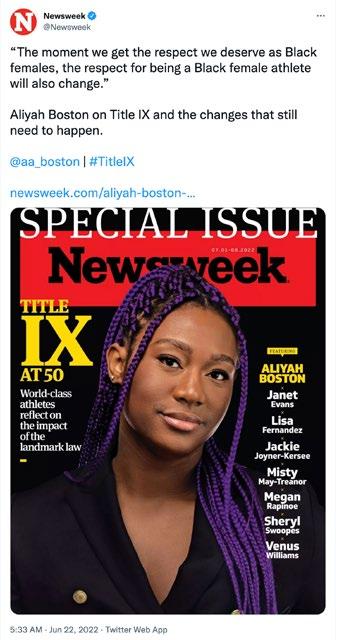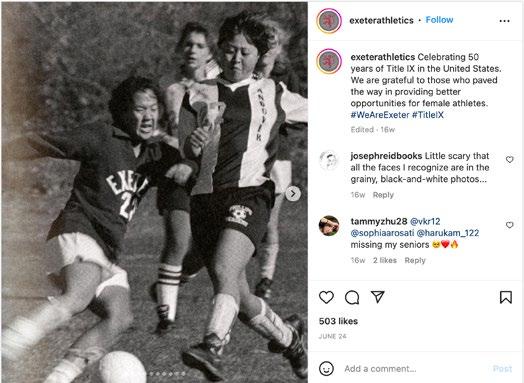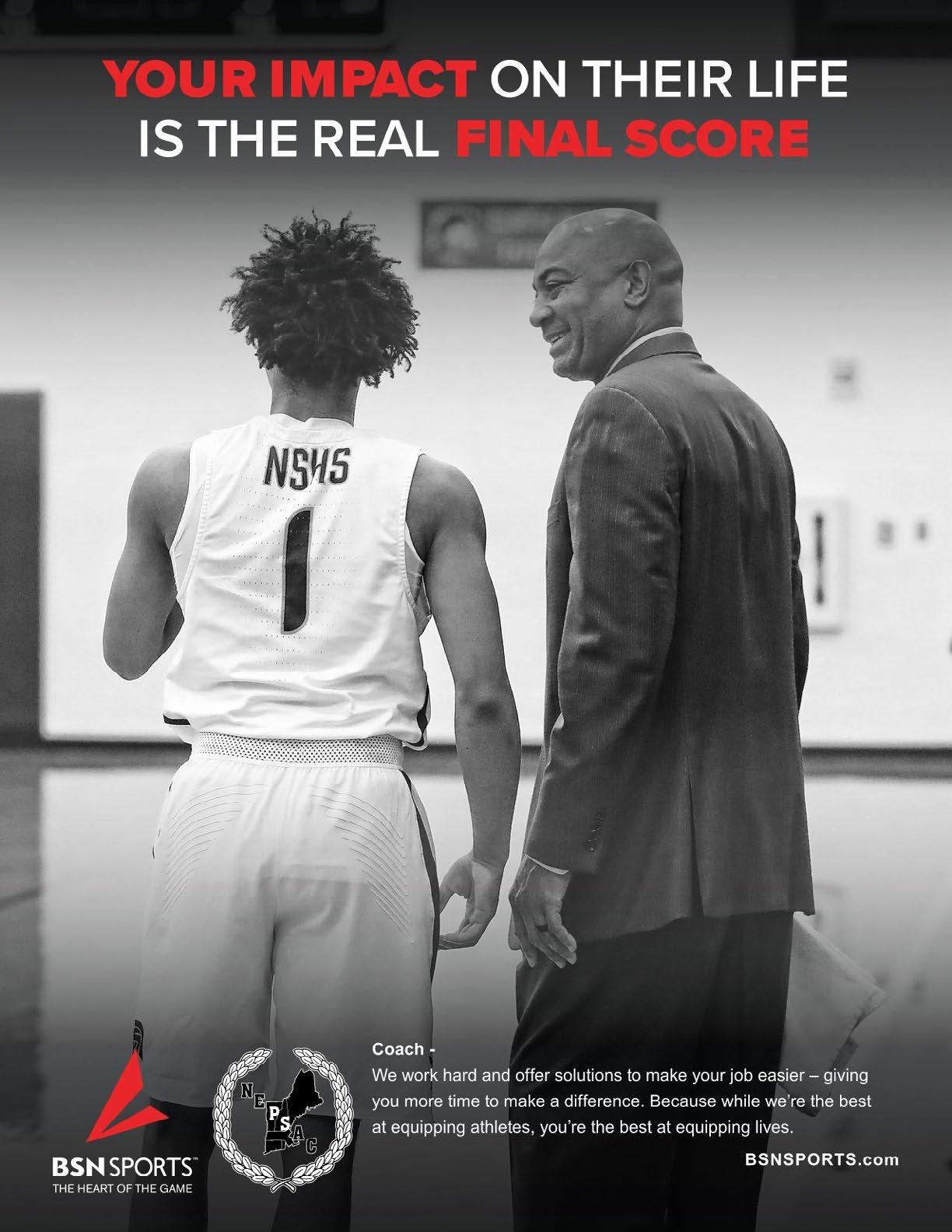








President
Martha Brousseau Greenwich Academy

Vice-President
Ryan Frost Cardigan Mountain School
Secretary
Rob Quinn Berwick Academy
Treasurer
Jim Smucker Berwick Academy
Co-Directors of Championships
Jamie Arsenault New Hampton School
Bob Howe Deerfield Academy
Lisa Joel Phillips Andover Academy
Director of Classifications
Mark Conroy Williston Northampton School
Coordinator of Diversity, Equity and Inclusion
Lamar Reddicks Milton Academy
Past Presidents
George Tahan Belmont Hill School
Bob Howe Deerfield Academy
Jamie Arsenault New Hampton School
Mark Conroy Williston Northampton School
Richard Muther St. Paul’s School
Middle School Representatives
Rob Feingold The Fay School
Amber Kuntz Beaver Country Day School
District I Representatives
Stefan Jensen Hyde School
Caddy Brooks Hebron Academy
District II Representatives
Tara Brisson Tilton School
Jenna Simon Holderness School
Connor Wells Brewster Academy
District III Representatives
Betsy Kennedy Pingree School
Jen Viana Cushing Academy
Sean Kelly The Wheeler School
District IV Representatives
Mike Marich The Frederick Gunn School
Tim Joncas Westminster School
Mo Gaitán Pomfret School
Catherine Conway School of the Holy Child
Communications Specialist
Laurie Sachs The Rivers School
“NEPSAC” and the NEPSAC logo are registered trademarks of the New England Preparatory School Athletic Council and may not be used or displayed without permission.
New England Preparatory School Athletic Council qualifies as a public charity under Internal Revenue Code 501(c)(3).

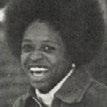
years of Title IX and women in sports
50 Years of Title IX and women’s sports at Proctor






ON THE COVER: Kate Turner retires from Brewster after a remarkable career.
Nadine Muzerall leads the Buckeyes to their first NCAA championship

Hoping that everyone’s year has been off to a good start and that reading this issue of the NEPSAC magazine provides you not just updates about what has been happening around our organization, but also serves to inspire you as we celebrate those inducted to their Halls of Fame, spotlight the Les R. McMillian Award and honor the passage of Title IX 50 years later with tributes from member schools, including the lasting impact of Kate Turner, a NEPSAC Distinguished Service Award recipient, who is retiring from Brewster Academy and NEPSAC’s first-ever woman to receive the Souders Award, Middlesex’s Patrica Melton.
As it should be, the focus of this issue is celebrating the passage of Title IX in 1972. The law reads:
No person in the United States shall, on the basis of sex, be excluded from participation in, be denied the benefits of, or be subjected to discrimination under any education program or activity receiving Federal financial assistance.
Many of us in the independent school world may be operating with the belief that Title IX does not apply to us as we are not “public schools.” As of late there have been challenges to this line of thinking based on the tax exempt status of our schools. Recently, culture wars have brought Title IX into headlines as some debate its application in the LGBGQ community. All of our independent school communities would be well-served by examining current practices and anticipating future applications of this law as we look to support our student-athletes. But the focus of this magazine is to celebrate the legacy of Title IX on our campuses, honoring those who have been the trailblazers check out those old-school uniforms and cheering on those still blazing trails!
See you in Boxborough!!

Please continue to update your school information in the online directory with any changes that you might have. This has been a much more efficient system and will allow schools to keep information more accurate. Look for reminders as we move forward. Contact Laurie Sachs communications@nepsac.org if you have any questions.
Online Payment Account: For efficiency and to help with our record keeping, we ask that you only create one online account per school.
Coaches’ Associations and District Banking Transfers: We are currently in the process of making the first transfers of dues for the fall sports.
Completed: Football, Girls Soccer, Volleyball, Boys Ice Hockey, Girls Ice Hockey, Boys Basketball, Girls Basketball, Alpine Skiing, WWNEPSSA, WNEPSSA, WNEPSFHA, District I, District II, District IV
To come: Boys Soccer, Wrestling, XC/Track, Swimming/ Diving, Field Hockey, Boys Tennis, Girls Tennis, Girls Golf, District III. NEPSAC anticipates moving forward with transferring these accounts to TD Bank so that these Associations can comply with NEPSAC’s 501(c)(3) status.
Jimmy Smucker will be in touch with the Associations’ presidents and treasurers to begin the process.
If you have any questions please feel free to reach out to Jimmy Smucker at jsmucker@berwickacademy.org or Laurie Sachs at communications@nepsac.org
to manage your athletic scheduling the same old way, using spreadsheets and post-it notes?

time to modernize your scheduling process with the

Scheduler+
with Google
Blackbaud,
Each
Hill,
contracts, notices, &

to

you
How
fundraising
overwhelmed?
even know where to start?
me help. I have over 25 years of experience with school publications and printing production, and I am accustomed to tight deadlines and equally tight budgets
can help you figure out what you want, pull the pieces together and deliver a final product you will be thrilled to share with parents and alumni.
The New England Preparatory School Boys Basketball Association (NEPSBBA) is proud to announce that John McVeigh, current Head of School at Holderness and former boys basketball coach at Brooks, as well as Joe Kremer, former senior associate director of admissions and boys basketball coach at Pomfret, are the 2022 winners of the Les R. McMillen Award.
with glioblastoma, an aggressive form of brain can cer with an aver age survival rate of 14 months. It was during his battle that Joe’s spirit re ally shined.
“In the summer of 2018, Joe went through a multi tude of surgeries and treatments to beat this disease. He approached each day with courage, tenacity, and his trademark humor,” said Rob Toste, a history teacher and former Boys Basketball coach at Pomfret. “That winter, as Joe con tinued to battle cancer, he joined me on the sidelines as an assis tant coach. Even with numberous doctor appointments and some experimental treatments, he never missed a practice, meeting, or game. Joe was not only a guiding light for our players, but he was also a mentor to me.”
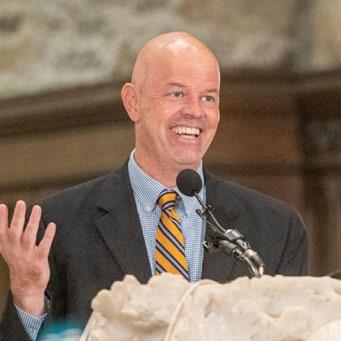
ew people can argue about Coach John McVeigh’s success during his time as the boys’ basketball coach at Brooks. There were seven ISL Championships. There were multiple trips to the NEPSAC Class B Championship game, including victories in 2016, 2017, and 2018. And there were countless young men who played for Coach McVeigh who not only have an outstanding foundation of basketball skills, but an acumen that reaffirms the best of role models in their formidable years. Coach McVeigh was that role model, not just for his players, but for his fellow coaches, too.

“John has been the go-to person for many coaches to talk through basketball, their team, and life,” says Keith Zalaski, Rivers Director of Athletics and Boys Basketball Coach. “The best teachers are the best listeners, and he’s been that person to his players and fellow coaches. No person has been able to dominate in the win column while also commanding the same level of respect as John. He’s a true teacher-coach and his impact on the game lives through so many coaches and teams.”
Coach Joe Kremer arrived at Pomfret as a decorated college basketball coach and not only reinvigorated the boys’ basket ball program at Pomfret, but his sense of humor and sense of community left an indelible mark well beyond the confines of the Connecticut campus. Although only head coach coach for 4 of his 12 years, Joe was an all around impactful member on the Pomfret community for 12 years and always remained close to the basket ball team. Sadly, in the early summer of 2018 Joe was diagnosed
Perhaps Joe’s “Chapel Talk” displayed this spirit the best as he shared his story with the Pomfret community. Coach Kremer embraced positivity in a challenging time highlighting the perspective this circumstance helped provide. When the pandemic hit, Joe had to be careful with exposure due to his condition, but it didn’t prevent him from mentoring players via text, joining team meetings on zoom, and even showing up to the occasional basketball workout. He maintained his connection as best he could, and when his health took a turn last fall, he still watched all of the Pomfret games on livestream from home and provided notes of encouragement to players.
Joe passed away in his home surrounded by his family on March 18, 2022, shortly after watching his favorite sporting event the NCAA tournament for the last time. The service that followed was filled with former players who came back to let his wife and two children know the impact Joe had on them.
Coach Les McMillen was a longtime athletic director and three-sport coach at the New York Military Academy. His teams were known equally for their talent and success as they were for their sportsmanship. In addition to his success mentoring and teaching young athletes on the court and playing fields, Les was also known among the basketball coaching circles in the prep school ranks for his consistent positive contribution to the experience of NEPSAC Boys Basketball and to the mission of NEPSBBA.


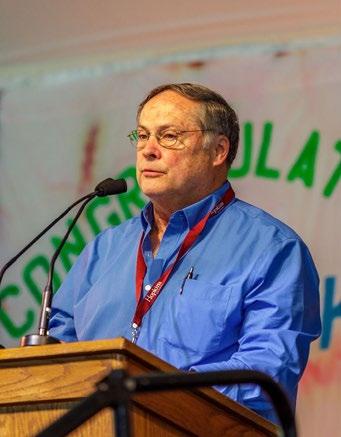
The Hopkins School community gathered to honor Coach Chuck Elrick at a reception on Saturday, June 4, 2022, on the occasion of his retirement after 39 years at Hopkins. Current and former swimmers, their families, and colleagues heard from speakers including Dr. Bynum, Director of Athletics Rocco Demaio ’86, Chuck’s first swim captain Ron Delfini ’84, and his daughter Elizabeth Elrick ’06. For a video of the day’s program, please visit https://vimeo.com/718410962


Choosing inductees for a school’s Athletics Hall of Fame, especially when the HOF is only in its second year, can be challenging for a variety of reasons, but sometimes the committee sees a resume as impressive as Konique Ballah’s and the group can let out a collective sigh of relief knowing that they have the right person.
Konique, a 1998 graduate of the Wheeler School in Providence, Rhode Island, was one of two individuals selected to Wheeler’s 2022 Hall of Fame Class. A five-time NEPSAC Champion in the 100 meters, 200 meters, and 400 meters, she quite literally put Wheeler Track and Field on the map. Prior to 1996, the Warriors did not have a program and Konique ran with nearby Hope High School in Providence. Her talent and success helped motivate Wheeler to form its own Track and Field team, and in the process, she became its first star.
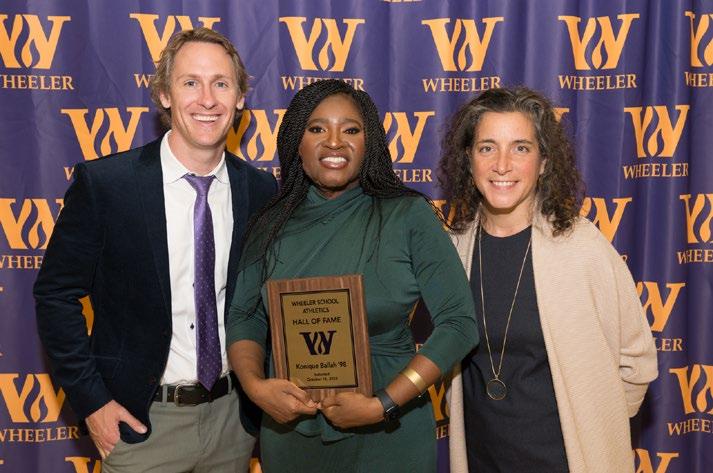
“Wheeler was a small all-girls boarding school until the late 70s when we started to phase out boarding and go coed,” says Sean Kelly ’02, Wheeler’s Director of Athletics. “We had a major role in the Title IX movement on the Rhode Island sports scene in the 70s with field hockey and tennis and coaches like Julie Baldwin, Jean Carlson, and MaryAnn Farroba. As the school grew and participation and popularity in girls’ sports grew, we naturally expanded our programming, but it was really Konique who single-handedly catapulted the change with track and set up our program that many female student-athletes have benefited from for the last 25 years.”
In 1996, Ballah won the NEPSAC Class C Championship for the 100 meters and then repeated as New England Champion in 1997 and 1998 in the 200 and 400 meters, respectively. Over the years she has held several Rhode Island state records.
“The school [Wheeler] supported me immensely by creating an athletic opportunity when it appeared there wasn’t one,” Ballah said at the Hall of Fame ceremony. “To be out here 25
years later and to see the progress of the track program, especially the physical track space at the Wheeler Farm Campus, I feel honored to be part of that beginning.”
After Wheeler, Konique competed and ran at Brown University and was a two-time team captain for the Bears.
“I learned many lessons participating in track,” Ballah said. “Discipline, resilience, and leadership stand out. I’ve formed lifelong friendships, too. I also had the opportunity to travel around the country and the world. One
of my fondest memories was competing on a combined team from Brown and Dartmouth who competed against Oxford and Cambridge in the UK.”
As schools and female student-athletes continue to embrace all of the wonderful opportunities related to females in sports, many of which did not exist over 50 years ago, it is important we celebrate those who created the foundation and those who played an integral role in that evolution nationally and in our own communities.
Got news to share with other NEPSAC schools? Send the details to communications@nepsac.org and we’ll put it in the next issue.
Left to right: Athletic Director Sean Kelly, Konique Ballah, and Head of School Allison Gaines Pell at the Wheeler School Athletics Hall of Fame Ceremony in 2022. Photo by Pam Murray.For many of you, Leslie Guenther, a.k.a. Ms. G., Coach G. or just Mitzi, was a constant of your Hebron years. She was your math teacher, your field hockey, lacrosse or ski coach, but today, we celebrate Leslie as athletic director for 23 years, one part of her many contributions to Hebron. Mitzi was tapped in 1997 to become Hebron Academy’s athletic director, and she quickly became a person who was “always there” for you and your teams. She fostered equity and inclusion to our athletic programs. With her leadership Hebron achieved Title-IX parity through the addition of girls teams, but more, she worked with coaches to ensure that all had good access to training facilities, fields spaces, courts and ice time, a particular challenge in the days before the creation of the Allen Field and Williams Center.
Networking, communication and cooperation are words that capture some of Mitzi’s talent for bringing people together. She became the long-serving president of our Maine athletic association, the MAISAD League, and later served for a decade on the Executive Board of the New England Preparatory School Athletic Council, or NEPSAC. Through those associations she was able to enhance Hebron’s schedules and exposure. And as our competitiveness increased,
Former Athletic Director Leslie Guenther, a.k.a. Miss G. (back row, second from right), was Hebron Academy’s assistant field hockey coach for 28 years.

so too did opportunities for expanded schedules. We met all of the Lakes Region schools of New Hampshire as well as perennial rivals Holderness, Brewster and Tilton. We regularly ventured further afield to compete with Dexter, Exeter, Governor’s, Milton, Middlesex, Pingree and others.
During Ms. G’s time, nearly all of our teams reached the NEPSAC tournaments: cross country, field hockey, football, and boys and girls soccer in the fall; basketball, both hockey teams and alpine skiing in the winter; lacrosse, boys and girls tennis and track in the spring 15 teams in all and of those teams, football, boys soccer, boys and girls hockey, alpine skiing, lacrosse, and girls track all brought home NEPSAC championship trophies. Mitzi also showcased our facilities and teams by hosting and being meet director for multiple NEPSAC championships in cross country and alpine skiing.
While our varsity teams experienced great success, Ms. G. also sought to create a positive and competitive experience at all levels of our program. Stories abound of the impressive runs by JV and thirds soccer, B-team hockey, and JV tennis. When the MAISAD group created the “MOXIE Award” to honor the member school with the most success at all levels during a year, Hebron proved a perennial winner. As well, our teams achieved a level of fair play as voted by our opposing coaches that kept a MAISAD sportsmanship banner on display here year in and year out.
all of Hebron’s program to create spaces for a wide variety of activities. From the beginning, she advocated for a community-based facility rather than a gymnasium. She was proud of the adaptable multi-season court spaces, the glasswalled weight room, the multi-purpose room and the climbing wall. But she was especially proud of pushing relentlessly for the inclusion of the suspended track, that signature feature that provides walking, jogging and exercise space for everyone in the community, and the space where we all go to “Pack the Track” and cheer our Lumberjacks.
In many ways, Leslie Gunther was a constant for many, many Hebron athletes. She was everpresent to do what needed to be done whether running the chains for football, timing innumerable field hockey, soccer, basketball and lacrosse games or having team needs always in hand: uniforms, referees, travel plans, and meal arrangements, the details that helped players and coaches be their best.
Leslie Guenther has been for Hebron athletics like the reflecting mirror behind the lantern of a lighthouse, a constant presence which amplified and enriched experiences, which helped all to shine and achieve great success and created a culture of excellence, cooperation and fair play in Hebron athletics.
An accomplished golfer, Leslie Guenther was inducted into the Maine Golf Hall of Fame in 2016.

Between 2006 and 2008, Ms. G. had the distinct honor of joining the architectural committee charged to design the Williams Family Athletic Center. Working with the lead architects, Mitzi turned her experience managing
It is thoroughly appropriate that we should celebrate Leslie Guenther’s 23 years as Hebron’s longest-serving athletic director with induction into our Athletic Hall of Fame, joining her name with icons Charles Dwyer, George Helwig, Addison Augusta, and Nat Harris exemplars all of excellence and service to Hebron.


NO PERSON IN THE UNITED STATES SHALL, ON THE BASIS OF SEX, BE EXCLUDED FROM PARTICIPATION IN, BE DENIED THE BENEFITS OF, OR BE SUBJECTED TO DISCRIMINATION UNDER ANY EDUCATION PROGRAM OR ACTIVITY RECEIVING FEDERAL FINANCIAL ASSISTANCE.
Fifty years ago, President Richard M. Nixon signed Title IX into law, and what an impact it has had in the last half century. Title IX opened up many opportunities for women, from simply being able to play on organized teams, to careers on the field and behind the scenes.
In the following pages you will meet some of the women who benefitted from this landmark legislation, as well as a new generation of athletes who continue to push the boundaries of what women can do in athletics.
In honor of forty years of coeducation, we begin our Q & A series with the women nominated for living their promise long after graduating from Middlesex. We will commence with Patricia Melton ’77. One of the first girls to attend Middlesex in the fall of 1974, Patricia is an award-winning educator who is known for her reform work with communities. Within urban school districts as varied as Seattle, Boston, Cleveland, and Indianapolis, Patricia has endeavored to inspire and help underserved students to become college graduates. She is now the president of New Haven Promise, a place-based scholarship program in Connecticut.
An outstanding athlete at Middlesex who earned nine varsity letters, Patricia was inducted into the School’s Athletic Hall of Fame in 2003. Primarily a sprinter at Yale, she was a seven-time individual Ivy League champion, a 1982 AllAmerican, and an Olympic Trials 800-meter finalist in 1988. In 1994, she became the youngest person and first woman to receive the [Martin William] Souders Award, given annually to a New England independent school graduate who has earned a distinguished record both athletically and professionally. These same qualifications subsequently brought her an NCAA Silver Anniversary Award in 2007 and a George H.W. Bush ’48 Lifetime of Leadership Award in 2013.

How did you find your way to Middlesex from Cleveland, Ohio?
I learned about Middlesex through Curtis Smith ’76. I was in a new school shortly after my mother died. I met a girl when we were both trying out for basketball; she made the team – and I didn’t! But we remained friends. She said, “I have a friend who is going to this school [Middlesex], and I think you would like this school, too. She gave me Curtis’ address, and we started corresponding. He told me about all these things he was doing at Middlesex – sports and plays. I was not doing any of those things at my school! I wanted to go there.
Were there adults at Middlesex who were particularly important to you?
Kathleen Locke was a young teacher living in the dorm; I definitely would go to her. I was really shy in the beginning, but John Briggs talked to me during the bus ride to a Spanish movie at Concord Academy. After that I knew, “Well, at least I can hold a conversation with one person!”Everybody loved Mary Adams, the English teacher who was from Texas.
Do you have favorite memories of Middlesex or favorite places here?
Though I was very shy in the beginning, one of the things I really wanted to try out for was one of Hugh Fortmiller’s plays. I got up the nerve to do it, and I was so incredibly nervous; my voice was just shaking! Hugh was so caring about it. He encouraged me to come back and try again. Of course, I didn’t make it that time, but I was eventually able to get into a couple of plays there.
How had Middlesex changed by the time you became a trustee (1988-91; 1992-2002)?
In those early days, Middlesex was unique. There were only about 40 girls, and you were the only girl in many of your classes. That was a pretty unique experience. Then, as more girls came to the School, it started to level out. At first, sports were so limited: field hockey, basketball, and lacrosse. And if you didn’t like that, it was tough!
Is your career today related to your own experience at Middlesex and Yale?
The transition from high school to college – that’s the thing I know a lot about! It’s not surprising that this is the career I have found. And if you think back to that time, you think it’s just you [having problems]. You need to talk to somebody! You need that caring adult.
What Middlesex did teach me is community – what it’s like to have people behind you and supporting you. I’ve realized that it is just so important to connect a kid with a community that resonates with them. When I look at New Haven Promise, I see so much potential in what we can do for kids to help support them. That’s ultimately what we’re working on: getting the right help for a kid who needs a mentor or more structure.
This article originally appeared in 2016 on mxschool.edu in 2016. In April Melton was named the 2022 Dick Enberg Award recipient. The Dick Enberg Award is presented annually by the College Sports Information Directors of America to an individual who has distinguished themselves nationally through their career achievement and meaningful contributions to society while promoting the values of education and academics.


“Sometimes I forget that I’m a woman in sports,” says Aleisha Roberts ’22.
When the boat drops in the water, the girls’ crew co-captain focuses on the only thing that matters—the team’s rhythm. Dialing in each movement, and the space in between, sets the boat from the top of everyone’s stroke.
Keep the starboard oar in the corner of your eye to time up the catch. Relax the slide. Recover on the three-count.
They all lock in together. A band playing in perfect time. This “team first” mindset led the girls to victory against Connecticut’s Kent School during a back-and-forth race in April that continued for all 1,500 meters until Andover pulled across the finish line first.
“But particular moments always remind me of the truth,” Roberts adds, pointing out times when being a female athlete can feel like rowing against the current. “Sometimes it’s boys trying to inflate their egos by comparing their performance to mine. Sometimes it’s repeating myself over and over and still being ignored. Being a woman in sports means encountering challenges of patriarchy and misogyny and having the courage to face it head on because I’m surrounded by other women who understand and love me.”
THE IMPACT OF TITLE IX ON WOMEN’S SPORTS IS SIGNIFICANT. THIS GAME-CHANGING LEGISLATION—PROHIBITING SEX-BASED DISCRIMINATION IN ANY SCHOOL OR EDUCATION PROGRAM THAT RECEIVES FEDERAL FUNDING— WAS SIGNED INTO LAW ON JUNE 23, 1972. BEFORE TITLE IX PASSED, ONLY 1 PERCENT OF COLLEGE ATHLETIC BUDGETS WENT TO WOMEN’S SPORTS PROGRAMS AND, AT THE HIGH SCHOOL LEVEL, MALE ATHLETES OUTNUMBERED FEMALE ATHLETES 12.5 TO 1, ACCORDING TO THE WOMEN’S SPORTS FOUNDATION (WSF).
Painting her nails blue, she adds, and getting the boat past a high stroke rate helps her push forward too.
While Phillips Academy does not receive federal financial assistance and is not subject to Title IX, the waves of change for gender equity that swept across the country greatly impacted the Academy, as the law dovetailed with a landmark event in the school’s history. In the fall of 1973, PA became coed. The first
generation of female students at PA chose to blaze their own trail in athletics, leaving legacies of excellence and advocacy.
“We have come so far since those who fought the fight to see Title IX pass,” says Lisa Joel, Andover’s athletics director and girls’ varsity soccer coach. “We stand on their shoulders and have the opportunities we have because of the path they paved.”
Fifty years from Title IX’s inception, Andover’s athletics community weighs in on the growth and obstacles in women’s sports.
“I think we’ve gotten to the point where women can exist and thrive in high-level sports,” Roberts says. “In the future, I’d love to see a world where it is no longer a battle to prove that we belong.”
“Sports will not be easy, and only you can decide if it’s worth it. If it isn’t, know that it is absolutely alright to seek joy elsewhere. If it is, never lose sight of what you’re fighting for and let absolutely nobody take that away from you.”Aleisha Roberts ’22 | crew
When Dianne P. Hurley ’80 arrived in the mid- 1970s, girls’ ice hockey was available for the first time. She jumped at the chance to join the team.
“Because we showed so much enthusiasm and dedication, girls’ ice hockey became a varsity sport the very next year,” Hurley recalls. The team had a packed game schedule and in Hurley’s senior year they were undefeated—which earned the team a steak dinner hosted by Head of School Ted Sizer, who had vehemently fought for and ushered in a coeducational Andover.
Hurley’s time playing hockey at Andover led to a four-year hockey career at Harvard—as well as one year of soccer and rowing intramurally. “Andover taught me to love many diverse sports and to be comfortable trying new sports,” Hurley says.
Other women broke gender barriers on teams that were already well established. Devin Adair ’82 became the first female coxswain on the boys’ varsity crew team at Andover. Her career was shaped and inspired by coach Martha Beattie.

“The women’s crew team was really serious and ambitious because Martha had high expectations for us,” Adair says. “She had been a champion oarswoman at Dartmouth and participated in the women’s national team camps. She was the first female athlete role model I had ever encountered and encouraged me to try out for the junior national team, helping arrange for me and some other ambitious female rowers to train in the summer. She mentored us to aim high and try hard. I was awed by her.”
Adair became close friends with a group of male rowers and was eventually asked to try out for the boys’ team. She went on to Harvard and became the first female coxswain on the men’s heavyweight crew team, leading them to a legendary victory against Yale. There wouldn’t be another woman on men’s crew for 30 years.

“The confidence and professionalism I developed as an athlete at Andover was crucial—seriously, the most important factor in my success at Harvard,” she says. “I don’t think I could have withstood the pressure of a Division I all-male program without the seasoning and training I had at Andover. I walked into the Harvard boathouse with total confidence that I could be a contender. Without that drive and confidence, I would not have lasted one season there.”
Becky Calder ’94 had a similarly formative experience playing basketball.
“My coach in nearly every sport and every season was Karen Kennedy—or just ‘Coach,’ as we called her—and she showed us what non sibi looked like every day. She coached us, taught us, parented us, fed us, sacrificed for us, challenged us, and loved us like her own. She showed us what hard work, grit, and determination looked like and what it was for: our team.”
The lessons Calder learned through her time at Andover—don’t give up and work hard for your team no
matter what that team looks like—helped her launch a successful basketball career at the Naval Academy followed by a 24year career in the U.S. military.
“My team turned into a squadron of F-18 pilots, and we quickly found ourselves at war after the events of September 11th,” she says. “The same hard work and sacrifice—the same non sibi spirit that I was taught by Karen [Kennedy] directly carried over onto the battlefield of Afghanistan and Iraq. We didn’t quit, we didn’t give up, and we worked hard.”
Calder says she’s often asked why she joined the military. “If I am answering that question honestly, it was because of basketball,” she says. “My love for basketball started at Andover and Andover truly taught me what it means to serve others.”
Before Title IX—and a four-decade career coaching girls’ sports—Calder’s mentor, Karen Kennedy, blew out her knee playing field hockey. Rules at her Danvers, Mass., high school prohibited trainers from treating female athletes. A surgeon was reluctant to operate, remarking that the scar would “look ugly” when she wore a bathing suit.
That was just the beginning of a long road strewn with obstacles Kennedy would be forced to confront because she was a female who wanted to play sports. She was even told by a male coach in college that “girls will never play soccer,” which he punctuated with a warning: if she stepped onto a field, she’d wind up in a hospital. “Female athletes were always as fierce as their male counterparts,” Kennedy says. “But 50 years ago, the narrative was different.”
After college, Kennedy landed a job coaching the first girls’ soccer program at Andover High School. She wrote a letter to the same college coach who told her girls would never play. “I wanted to share the news and tell him times were changing and that going forward, I hoped he would treat female and male athletes better,” she says.
Some 30 years after Title IX became law, in the ’90s, Kennedy, now an instructor in athletics at Andover, recalls a major victory when 11 seniors from the girls’ varsity soccer team went on to play collegiate sports, many at the Division I level. This was, Kennedy adds, “extraordinary” proof that girls could in fact compete at a high level.
“I call myself the pebble in the shoe,” Kennedy says. “It’s constant work, and it shouldn’t have to be, but we have to keep saying and believing, ‘my life is as important as yours.’ We have to keep chipping away.”
1976 Girls Crew. Photo courtesy Phillips Academy Archives.I CALL MYSELF THE PEBBLE IN THE SHOE. IT’S CONSTANT WORK, AND IT SHOULDN’T HAVE TO BE, BUT WE HAVE TO KEEP SAYING AND BELIEVING, ‘MY LIFE IS AS IMPORTANT AS YOURS.’ WE HAVE TO KEEP CHIPPING AWAY.”
KAREN KENNEDY INSTRUCTOR, ATHLETICS
By the turn of the millennium, the effects of Title IX were clearly visible as female students be- gan coming to Andover with significant athletic achievements. Hee-Jin Chang ’05 swam for South Korea in the 2000 Summer Olympics in Sydney Australia, when she was just 14 years old. So it’s no surprise that while attending Andover she set school records in nine of 11 swimming events—two of which still stand today. Chang went on to swim at the University of Texas at Austin and in the 2008 Summer Olympics in Beijing.
But Chang’s Andover athletics story has just as much to do with what she didn’t excel at.
“I was a great swimmer when I joined Andover,” she says. “But I did not want to—or was afraid to—try new sports.” The best thing about Andover athletics, Chang notes, was that she wasn’t allowed to be just “the swimmer”—a gift she attributes to Martha Fenton ’83, P’17, ’21, ’23, current girls’ hockey coach and former athletics director.

“Martha encouraged me to try other sports, like rowing,” Chang recalls. “And I loved it. I always think of Martha when I am afraid to venture into new areas in life—she’s always in the back of my mind, encouraging me to make the leap into the unknown.”
Others also tried new sports, which ended up becoming a central focus in their lives going for- ward. Case in point: Kassie Archambault ’06, who decided to join the wrestling team her first year with no prior experience. By her lower year, she’d made
the varsity line up. The support she received at Andover felt groundbreaking for her.
“When I started, I took for granted how supportive our coaches and team were of girls wrestling,” Archambault says. “Once I made varsity, I realized that wasn’t the case at other schools. We were certainly ahead of the game.”
Although Archambault didn’t wrestle in college, she returned to the sport when she came back to Andover in 2012 as a teacher. She is currently chair of the Russian Department, assistant girls’ varsity lacrosse coach, and head varsity wrestling coach, having recently been named New England Preparatory School Wrestling Association Coach of the Year.
The wrestling world has come a long way since her time as a student, Archambault says. And Andover has continued to help pave the way. “When I was an athlete, we had to look elsewhere for all-girl tournaments—my coaches would take me to the local ones and then my family would take me to tournaments that were further away,” she says. “Now all prep schools are on board with girls wrestling and there is a girls’ division at the New England championships and the Prep National Championships. I could never have dreamed of that as a student.”
Julie Wadland ’06 also cites Andover athletics as laying the foundation for her life beyond the Hill. She earned 12 varsity letters—in soccer, ice hockey, and lacrosse—but when asked which experiences stand out the most, she points to Andover’s biggest rival to the north.
“To me, Andover-Exeter embodies the spirit of athletics at Andover—it strikes a balance between competition and community,” Wadland says. “I always found the spirit of connection between fellow teammates, faculty and staff, alumni, and families very moving; it was and is a demonstrative example of how we can accomplish far more—and have fun along the way—by coming together and supporting others.”
Wadland went on to play lacrosse at Dartmouth College; her junior and senior years, she captained the team. In 2019, she was inducted into the Andover Athletics Hall of Honor. Today, Wadland works as an associate director of admissions at Concord Academy, a private coeducational high school. Working with young people
THIS DYNAMIC PLAYED OUT IN COMPETITION: “PEOPLE THOUGHT WE WERE MAKING A STATEMENT BY PUTTING A GIRL OUT AS THE VARSITY 103-POUNDER, NOT REALIZING THAT I HAD BEATEN TWO OTHER BOYS FOR MY SPOT. I HAD BOYS WHO REFUSED TO WRESTLE ME IN COMPETITION AND THEREFORE WOULD JUST FORFEIT.”1995 Girls’ Diving. Photo courtesy Phillips Academy Archives.
every day, Wadland draws upon her Andover experience.
“The support I received from my Andover coaches, friends, teammates, and teachers offered me a founda tion built on confidence, reas surance, and love in the pur suit of my goals as a collegiate student-athlete,” she says. “That pride, tradition, and love continue to frame how I pur sue my own work today.”
Although her experience as a student-athlete was over whelmingly positive, Wadland acknowledges the many hurdles that lie ahead. “Female-identi fying student-athletes were well-respected during my time at An dover,” she says. “We are beginning to see that similar respect extended to women in professional sports—increased media cov erage, slight compensation increases. But progress remains slow.”
Over five decades, Title IX has paved the way for glimmers of progress. In May, the U.S. women’s soccer team settled a lawsuit with the sport’s national governing body, which pledged to equalize pay for the men’s and women’s national teams. But what should have been a revolutionary step forward in gender equality has its shortcomings.
“Equity and equality are not the same,” says Aisha Jorge Massengill ’88. The vice president and deputy general counsel of employment and teammate relations at Under Armour, Massengill was appointed to PA’s Board of Trustees in July.
Massengill made history at Andover as the first athlete to earn 12 varsity letters in four years (in volleyball, softball, and basketball). She went on to play Division I softball at Boston College, where she studied law. Sports helped show Massengill what she was capable of and taught those who watched her
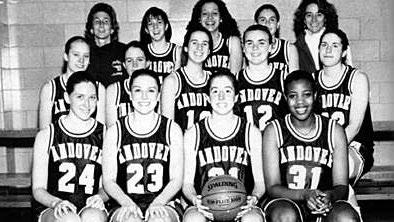
never to underestimate what a female can do.
“Sports helped change how women saw themselves and how the rest of society saw us,” Massengill says. But now, she adds, that feels at risk.
A day after celebrating the 50-year landmark passage of Title IX this past June, the U.S. Supreme Court overturned Roe v. Wade, declaring that the constitutional right to abortion, upheld for nearly half a century, no longer exists. The decision, which put the power in the hands of state governments, prompted abortion rights to be totally or near- totally banned in 26 states.
“While there has been tremendous progress in women’s athletics, we cannot be complacent,” Massengill says. “The Roe decision and the state laws that have since followed highlight that the gains we have made are tenuous at best. Our right to live and compete on equal footing—and to have agency over our bodies— must be vigilantly protected.”
As optimistic as she feels about women’s sports, Athletics Director Joel reminds that we still have a long way to go. “All female athletes deserve equal access to top-tier facilities, locker rooms, trainers, coaches, equipment, and uniforms—the same as the boys deserve,” she says. “We also must understand that the news coverage of girls’ and women’s sports often falls short. The stories of female athletes at all levels must be told and celebrated—they cannot be the side or back story but should be right alongside the stories about male athletes.”
Joel is also quick to recognize the importance of men who fiercely advocate for equality—like her friend and mentor, retired Andover football coach and emeritus athletics director Leon Modeste. “Leon was truly ahead of his time,” Joel says. “He not only fought for girls’ sports, but also took action by hiring women coaches.”
When Modeste joined the coaching staff in 1986, changes were underway. Coaches, he stresses, play a fundamental function, working closely with athletes to develop physical, technical, and psychological improvements. In addition to exceptional coaching, Andover also prioritized equal access to facilities and equipment.
“Things really started to change when people began getting turf fields,” Modeste says. “Some schools would put boys on their main field and place the girls on secondary fields that weren’t as visible or well maintained. We were reluctant to play schools that put our girls on other spaces.”
When the Academy switched to turf, Modeste made sure the field hockey lines were permanently painted on the field in adaddition to the football lines.
“This shouted to the world that both these teams were equally important—literally playing on the same turf,” he says. “Our girls’ teams are as driven and aggressive as any of our boys’ teams. That’s the Andover way.”
On campus today, female athletes continue to be trailblazers in their sports and are unafraid to point out the challenges they
THE SUPPORT I RECEIVED FROM MY ANDOVER COACHES, FRIENDS, TEAMMATES, AND TEACHERS OFFERED ME A FOUNDATION BUILT ON CONFIDENCE, REASSURANCE, AND LOVE IN THE PURSUIT OF MY GOALS AS A COLLEGIATE STUDENT-ATHLETE.
JULIE WADLAND ’061996 Girls’ Basketball. Photo courtesy Phillips Academy Archives.
face—and the progress that remains for gender equality more broadly.
While crew captain Roberts says that team sports benefit her in many ways, including inspiring gratitude, she also recognizes the road toward equality is long and winding.
“An important issue for women in sports right now is the hate that is directed toward women who occupy additional marginalized identities—trans women, women of color, women with disabilities,” she says.
Many of the student-athletes, as well as alumni and coaches, refer to the case of Brittney Griner, a seven-time WNBA All-Star, who was detained in Russia on February 17 for carrying marijuana concentrate (cannabis oil) in her luggage. The star center for the Phoenix Mercury (who was sentenced to nine years in prison at the time of publication) was in Russia to play during the WNBA off-season. Roughly half of WNBA players compete overseas in the off-season to augment their domestic income. Griner’s counterparts in the men’s league make more than 200 times the maximum WNBA salary.
“She’s every bit the Tom Brady of her sport,” Modeste points out. “It is crazy that WNBA players make so little that they have to go overseas to supplement their income. They work just as hard as male players do, yet you can’t deny that more people pay to see a team like the New York Knicks lose instead of the Liberty (WNBA), who actually win games! That’s a societal problem.”
While society catches up, the current generation of female athletes presses ahead. Roberts, who graduated in June, would like to see more room for women to not have to be incredible at a sport to be respected.
“I want women to be comfortable trying sports just for fun, with any body type, at any skill level, and feel like they belong,” she says.
Shea Freda ’24, who plays field hockey, ice hockey, and lacrosse, hopes to see more girls play longer—girls are dropping out of sports at two times the rate of boys by high school (around 51 percent), according to the WSF. Freda also hopes to turn on the TV in 10 years and watch “women’s sports broadcast equally to men’s.”
“We battle being overlooked, underpaid, and underestimated,” Freda says.
“As I see it, each female athlete may be a competitor, but we compete for each other.”
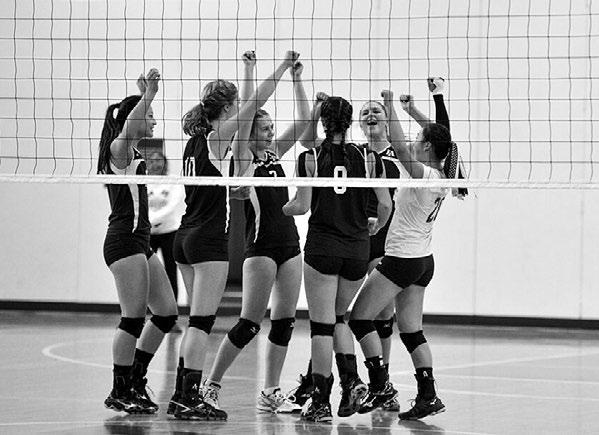
Myra Bhathena ’22 likewise believes that female athletes are bound not only to one another, but also to women
throughout history who have fought and continue to fight for equality. She often feels the weight of the struggle.
“Every time I step onto the field or track,” says Bhathena, “it can feel burdensome to continuously have to prove my—and all women’s—place in athletics. Being a female in sports should not be an exception, although we still often feel like outsiders in such male-dominated spaces. To me, being a female in sports is a privilege. I hope that soon it will become an empowering norm.”
While there are still barriers to break in reaching equality, women, the students echo, are more visible in sport now than ever before. And they aren’t backing down from leveling the playing field.
2016 Volleyball Team“Find the sport that makes you happy, less stressed, or gets you excited,” says Sakina Cotton ’24, who wrestles and plays Ultimate Frisbee. Prior to games, she likes to queue up Alicia Keys’ “New Day” to get in the zone.
“We are still working on amending the sports disparity between males and females,” Cotton says. “But know there are many people out there who want to see you shine and support you. You just have to find your people—and never stop believing in the power of you.”
OUR GIRLS’ TEAMS ARE AS DRIVEN AND AGGRESSIVE AS ANY OF OUR BOYS’ TEAMS. THAT’S THE ANDOVER WAY. ”
LEON MODESTE EMERITUS ATHLETICS DIRECTOR
WE HAVE COME SO FAR SINCE THOSE WHO FOUGHT THE FIGHT TO SEE TITLE IX PASS. WE STAND ON THEIR SHOULDERS AND HAVE THE OPPORTUNITIES WE HAVE BECAUSE OF THE PATH THEY PAVED.”
LISA JOEL | ATHLETIC DIRECTOR AND GIRLS’ VARSITY SOCCER COACH




can spend more time impacting the
First of its kind, the WoW program is exclusively offered by BSN SPORTS & Under Armour. Only a small percentage of schools in the country are sought out to join our Women of Will Family.


Women of Will athletes gain the confidence to pursue their goals and dreams while tackling adversities that come their way.
AD’s, coaches, and athletes have a full service team through BSN SPORTS and Under Armour to help save you time and grow your athletics programs. Through the WoW program, your teams will have access to the best performance gear in the game built specifically to fit the female athlete’s body.
As a team with your BSN sales pro, we are ready to help answer your UA product questions and launch this program at your school!

 by Scott Allenby, June 23, 2022
by Scott Allenby, June 23, 2022
On June 23, 1972, 50 years ago today, President Richard Nixon signed into law Title IX banning sex discrimination in educational programs receiving federal funding. Title IX’s impact on women’s sports around the country, and at Proctor, has been remarkable. More than 3.4 million high school girls compete in sports and more than 215,000 women play in NCAA athletics.
Today, we recognize those women (and men) who built Proctor’s female sports programs starting with basketball, volleyball, and lacrosse in 1974, followed by soccer in 1975, cross country running, tennis and skiing in the late 1970s, softball in 1980, and ice hockey and field hockey in 1981.
Some of Proctor’s earliest female coaches, like Sarah Will pictured right with the girls varsity soccer team in 1981, were crucial to the development of female athletics at Proctor. Sarah recalls coaching both the varsity and jv girls soccer teams, driving
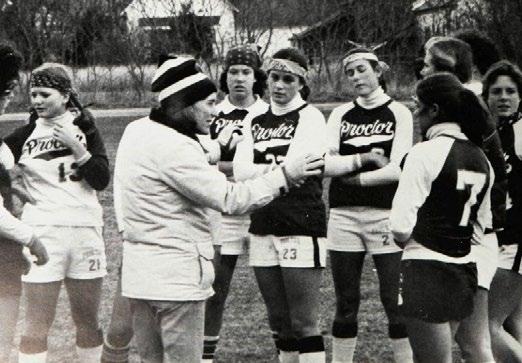
the bus to coach back to back games, and then returning late to campus to her family, plenty of English papers to grade, and dorm duty. To this day, the commitment of our coaches to their players, teams, and the school is absolutely critical to the building of a strong school culture.
Dani Hinkley (above) was Proctor’s first girls soccer coach, as well as a ski and softball coach, helping lead the 1978 soccer team (bottom) to an undefeated 14-0 record. Dani was inducted into the Athletics Hall of Fame alongside her husband, Bert, at this past June’s Alumni Reunion.
While Proctor’s early female coaches built positive experiences for our female students, it was the school’s leadership under Head of School David Fowler and Assistant Head of School Chris Norris that allocated the resources necessary to ensure coaches and athletes had opportunities to build their programs. Pictured next page top, Assistant Head of School Chris Norris coaches the 1981 softball team.
Right, Tom Eslick and Head of School David Fowler stand alongside Proctor’s first girls ice hockey team in 1981–1982. Thirty years later, Proctor’s 2012 ice hockey team would win its first NEPSAC Championship.
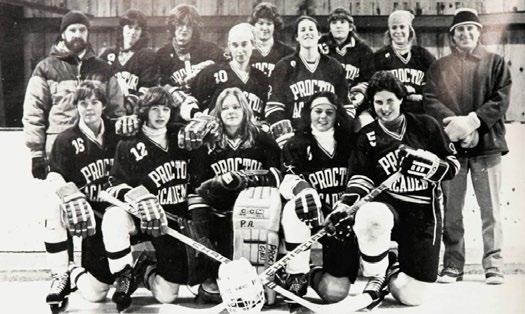


A look through old yearbooks from the mid-1970s visually shows the rapid evolution of women’s sports at Proctor. The image below is from the 1974 yearbook and Proctor’s inaugural girls basketball season. Yes, in 1974 some girls basketball players wore dresses during competition!

Today’s Proctor female athletes have access to participate in 21 varsity sport offerings. These opportunities would simply not exist without the passing of Title IX and the national movement to support women’s sports. We know there is still much work to be done on the national level around pay equity and opportunities in professional sports, just as there is more work to be done to support nonbinary athletes participation in high school athletics. Relationships formed through athletics are absolutely critical to a school’s culture. Our goal at Proctor is to lead by example, to continually evolve, to listen to our students, and to work tirelessly to ensure students and coaches have positive experiences through athletics.


 Kate Turner with Athletic Director Connor Wells. Photo by Pat O’Connor.
Kate Turner with Athletic Director Connor Wells. Photo by Pat O’Connor.
Kate Turner. Supportive. Dedicated. Mentor. These words are but a few of the descriptions that come to mind when thinking of Kate Turner. Her 35 year-tenure at Brewster is incredible, as are the bonds she has created among our student athletes, coaches, families, and colleagues. Ms. Turner began as Assistant Athletic Director in 1986, when she also founded our field hockey program. She became our venerable Associate Director of Athletics, and throughout her years at Brewster, when not sharing in the responsibility of oversight of our athletics programs, she has coached alpine skiing, lacrosse, JV tennis, field hockey, and most recently JV field hockey. Many admire the way she has promoted and supported our JV teams, making sure every student had a chance to shine—and to experience the competition and camaraderie of athletics. She once told a new employee that one of the best ways to really get to know the heart and soul of Brewster was to simply swing by the field and watch a JV practice.
For more than two decades, Ms. Turner, whose son Peter graduated in the Class of 1990, served on the board of our governing athletic body, the New England Preparatory School Athletic Council (NEPSAC), and in 2016–2017 that organization recognized her with its Distinguished Service Award.
Like her fellow retiree Raylene Davis, Ms. Turner is a double honoree at Brewster. Students dedicated the yearbook to her in 2011 and again this year in 2022. Both times, students cited her listening ear, strong advice, constant smile, and willingness to help students as just some of the reasons that the class selected her for this honor an honor that comes with receiving the very first Winnipesaukean off the presses and reading all the graduates’ names at Commencement.
“Kate has truly dedicated herself to making Brewster’s athletic programs respected both internally and externally,” longtime colleague Lynne Palmer shared recently. “She is a tireless advocate who cares deeply about the traditions and the details and never hesitates on either.”
Former Head of School Craig Gemmell also recalled Ms. Turner’s dedication to Bobcat Nation when he told us recently, “Kate, in her relentless devotion to students and to our athletic program, manifested the very grit and teamwork our athletic program has long aspired to instill in our students. She thus lived and taught and led by example no better way to leave a legacy!”
This year, as Commencement drew closer, Athletic Director Connor Wells said: “Kate Turner is one of those special boarding school educators whose consistent presence and good work has come to personify the institution. In our one year together, I have been blessed to work with not only a dedicated professional who loves her school and community, but, even moreso I have witnessed and learned from a veteran mentor, who above all else, loves the students she works with. Kate inspires me every day to be a more driven coach, a more compassionate teacher, a more reflective Director, and simply a better person. The passionate love Brewster’s community has for its school is because of folks like Kate Turner.”
It’s doubtful that Kate Turner could ever have foreseen being bestowed an honor that in prior years had been presented to longtime Taft School athletic director and legendary baseball coach Larry Stone, fabled Greenwich Academy field hockey and lacrosse mentor Angela Tammaro and Ken Martin, who won more hockey games at Belmont Hill School than any other high school or prep school coach in Massachusetts history.
For Turner, however, fantasy gave way to reality during the New England Prep School Athletic Council’s Annual Meeting on Friday, Nov. 19, 2016, at the DCU Center in Worcester, when its board presented her with its Distinguished Service Award.
Since 1984, the Distinguished Service Award recognizes an individual “who has contributed significantly to New England
At the 2022 Moving Up Day Ceremony, Head of School Kristy Kerin announced that Brewster’s annual Athletic Director’s Award will forevermore be called the Kate Turner Athletic Director’s Award. At the moment the announcement was made, the stands of the Smith Center, filled with Bobcats, erupted into an ovation that shook the rafters! independent school athletics and physical education through enthusiasm, dedication, leadership and vision.”
Turner believed that someone had dialed a wrong number when she was initially notified of her nomination.
“I was both thrilled and honored that the people at NEPSAC wanted to present me with this award,” acknowledged Turner, who has been a fixture in the Brewster Academy athletic department both in the office as well as in the school’s various athletic arenas since arriving on the Wolfeboro, N.H., campus in 1986.
Turner’s first fall at Brewster saw her revive a field hockey program that had been on a 15-year hiatus. She kept herself busy that winter by helping tutor the Bobcats’ alpine ski team, while she headed up a two-year-old the girls lacrosse program in the spring. Her second year there, she was named Brewster’s associate athletic director, a position she still holds 29 years later.
“It’s a very prestigious award and a lot of outstanding people have won it … I’m very humbled that the council thought
me worthy of it,” said Turner, who has earned legendary status among NEPSAC members for the job she performed as the council’s director of publications.

As head of publications, it was Turner’s job to gather information from the council’s 168 schools, and then publish it in NEPSAC’s annual directory. It was a position Turner volunteered to fill in 1987, and with the exception of a six-year hiatus in the late 90’s, she kept member schools updated on each other through 2010.
Except for the mail person, who visited Turner’s mailbox on a near-daily basis, it’s doubtful anyone, anywhere, could appreciate the job Turner did more than her successor, Laurie Sachs.
“I would say that the task of compiling all the information for what was at least 160 schools at that time was simply an enormous accomplishment each and every year,” said Sachs.
“These days, I use electronic everything…forms, mail, databases…and I know Kate did not have all of that at her disposal,” added Sachs. “She did all of what I do, but without the help of much technology, and that must have made things far more tedious. When I started in my position, Kate’s guidance was much needed and appreciated, and I know that I could call upon her to this day for help. That’s the type of person she is, always a hard working, team player.”
“And I did most of that work sitting at my dining room table,” quipped Turner.
“I can’t think of a more deserving individual to be honored by NEPSAC for the Distinguished Service Award,” said Janna Anctil, a former Brewster Academy student/athlete who is the current field hockey coach at The Rivers School. “The four words that the recipient must possess depict Kate perfectly: enthusiasm, dedication, leadership and vision. During my time at Brewster, Kate was one of my role models.”
Turner modestly credits her nomination for the Distinguished Service Award as simple as “being in the right place at the right time,” and when you think about it, the explanation makes sense.
She appears to have been in the right place at the right time during her high school days when she attended Milton Academy,
then graduated from Beaver Country Day School. During her independent school days, she not only received an education that got her into Centenary College, but was able to get up close and personal with a prep school athletic career.
“Back in my day, prep schools, compared to public schools, were way ahead of the curve as far as girls sports were concerned,” said Turner, who competed in both field hockey and lacrosse at both Milton and Beaver Country Day. So, after graduating from Centenary College Turner took a teaching job at Kingswood Regional High School, which is also located in Wolfeboro. Early on, she was asked to help out with the Kingswood Middle School field hockey program.
“I jumped at the opportunity,” remembers Turner, who admitted at that time, few women had had the opportunity to have played competitive sports in high school and college, “so, with my experience as a player, I felt completely comfortable helping coach the field hockey program.”
Three years later, Turner moved on down the road to Brewster Academy, and the rest, as they say, is history.
“Without a doubt it is Kate’s unassuming humility that makes her so approachable and endearing to those she has molded and mentored,” said Anctil. “Although Kate was never a coach of mine throughout my time at Brewster, I always felt like her office was a place I could go and chat, get advice, or just regroup before a big game. The conversations and hours spent in her office are some of my fondest memories at Brewster.
“Wolfeboro, Brewster Academy and NEPSAC are better for having Kate’s presence within their ranks,” added Anctil, “as are the many students and student/athletes who will undoubtedly smile when recalling their time with her at Brewster.”
Kate Turner with family members, friends and Brewster Academy colleagues at the NEPSAC Annual Meeting in 2016.AT THAT TIME, FEW WOMEN HAD HAD THE OPPORTUNITY TO HAVE PLAYED COMPETITIVE SPORTS IN HIGH SCHOOL AND COLLEGE, “SO, WITH MY EXPERIENCE AS A PLAYER, I FELT COMPLETELY COMFORTABLE HELPING COACH THE FIELD HOCKEY PROGRAM.”


When Nadine Muzerall ’97 took over the Ohio State women’s hockey team in 2016, she inherited a program that had never qualified for the NCAA tournament. On March 20, she coached the Buckeyes to their first-ever national championship with a 3-2 defeat of Minnesota Duluth. The Buckeyes “looked brilliant,” Muzerall says. “This was one of the best hockey games they played all year.”
It’s a sport in which she has excelled on both sides of the glass. The Mississauga, Ontario, native first picked up a hockey stick at age 3 and recounts the days she and her brother spent preparing to play.

“We flooded our backyard for days and days, thumb to hose to spray water on top of the grass, pack down more snow, switch fingers, and then he’d take a turn while my two thumbs thawed out.” When KUA Coach Peter Bartlett came calling, Muzerall’s mother urged her to consider the academic and athletic opportunity.
“She was thinking big picture, of course, now that I’m a mom I understand,” says Muzerall. “I needed the individual attention of 10 to 12 people in class. And the personal relationships with the faculty and students and the feeling of family and support was much appreciated when I was a 13-year-old away from home.”
In Meriden she played hockey and soccer winning New England champi onships in both sports and ran track. She went on to play at the University of Minnesota, where she was a two-time All-American and her record of 139 goals still stands. There, she also studied ado lescent behavior and wondered how to combine her desire to work with young adults with her passion for sport. “That’s where [KUA Coach] Lori Charpentier came in,” says Muzerall. “She told me Northfield Mount Hermon was looking for a hockey coach and a soccer coach.” But the transi tion from player to coach was challenging. “You can’t control the outcome. You can only prepare them as best as you think, and it’s then something that you pass
on and hope that they execute.” Muzerall eventually returned Minnesota as an as sistant coach and scored the distinction of winning multiple national championships 2000 and 2001 on the ice; 2012, 2013, 2015, and 2016 behind the bench.
Then came the job offer from Columbus. In 2018, Muzerall says, when she took the head coaching job, she set a five-year goal to match her initial, five-year contract: to make a Frozen Four. When she made that goal in two years, she refocused on other goals. Muzerall has now coached her team into the NCAA tourney four times, reaching the Frozen Four in all three that were ultimately played. She has earned conference Coach of the Year honors three times in five years and hit various program milestones, including a the 32win season that smashed the previous record of 24. And in an international testament to her coaching talent, three of her student-athletes represented their respective countries in this year’s Beijing Olympics, with one winning gold with Canada, another earning silver with Team USA, and a third backstopping the Swiss to the bronze medal match.
Now that the Buckeyes have completed one of the most improbable turnarounds in women’s college hockey history, Muzerall can take a moment to enjoy being on top. “This is something that’s forever,” she says. “The amount of pride that you left a legacy it does feel very sweet.”
This article first appeared in the Spring/ Summer 2022 issue of Kimball Union magazine. Reprinted with permission.
Head Coach Nadine Muzerall of the Ohio State Buckeyes reacts after the Buckeyes defeated the Minnesota Duluth Bulldogs 3-2 during the Division I Women’s Ice Hockey Championship held at Pegula Ice Arena on March 20, 2022, in University Park, Pennsylvania.

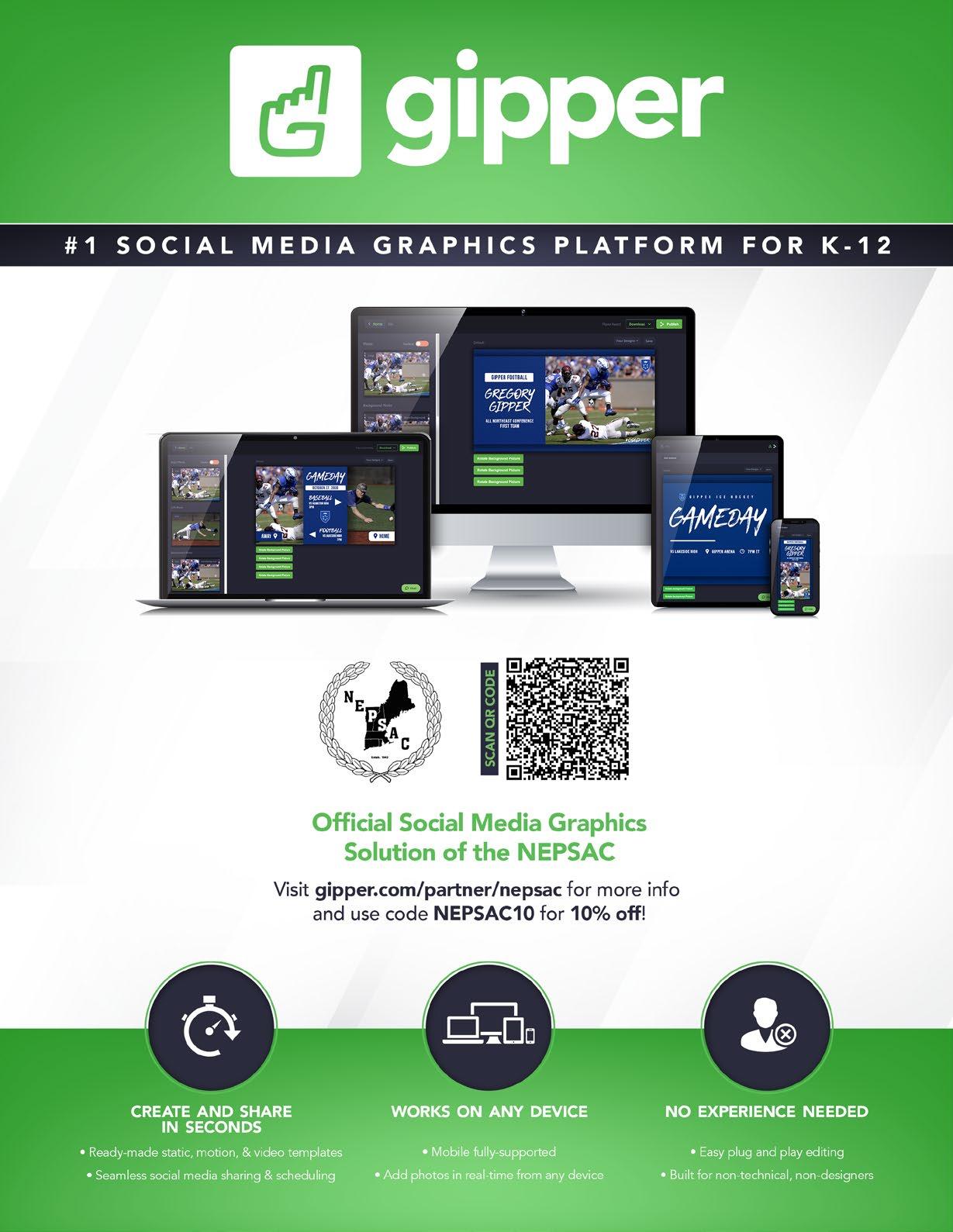
Hockey fans eagerly tuned in to the Olympics last February to see the much-anticipated gold medal match-up between the top-ranked women’s teams from the United States and Canada. But no one was paying closer attention than Kendall Hanley ’04. As a linesperson for the international four-woman officiating crew, Hanley was on the ice with whistle in hand for the thrilling (some might say heart-breaking) 3–2 Canadian victory.

As with other Olympians, Hanley’s rise to the pinnacle of international sport was a multiyear journey that demanded perseverance, hard work, and personal sacrifice. Having reached the top of her profession with a cohort of other women who now officiate hockey at every level short of the National Hockey League, she continues to break barriers in her new position as manager of officiating for the North American Hockey League, a top junior league. Still, working the Olympics was a particular thrill.
“It’s just such an honor and a privilege to be able to do what you love, and do it at the highest level,” explains Hanley, who was one of 22 women officials selected for Beijing. “It’s amazing what you get out of it: camaraderie, working together as a team, and serving the game. Those are all the things that as a player, you think, This is why I do this.”
And Hanley knows well the joys of being a player, having transferred her junior year from North Carolina to skate with the Wildcats (she also played volleyball, soccer, and softball at Williston). Determined to compete at the collegiate level, she stayed through a postgraduate year and soon established herself as a team leader both on and off the ice, recalls Christa Talbot Syfu ’98, then just beginning her Williston hockey coaching career.
“She was a phenomenal player,” Talbot Syfu says. “Very skilled,
and more mature than many of her teammates. She was probably head and shoulders better than anybody else on the team.”
That talent would lead Hanley to women’s hockey powerhouse Elmira College, then to SUNY Oswego, where she transferred to pursue a degree in zoology. But it was her experience off the ice at Williston that she says provided the strongest foundation for her success in hockey today. Officiating demands “a lot of time management,” explains Hanley, who when not traveling to games and tournaments lives in Minneapolis with her partner, her partner’s mother, and her golden Labrador. “I learned at Williston how to balance my schedule, how to manage my time, attention to detail, and being able to operate independently. These are all invaluable life skills. I grew as a person at Williston, and that allowed me to be successful in my role.”
Officiating wasn’t something she even considered as a player, though she certainly was familiar with the refs. “I had a lot of penalty minutes,” she says with a laugh. “There’s a fun photo of me as a kid sitting in the penalty box with my dad, who was the penalty bench attendant. I’m like, ‘Yup, this is how we spend family time.’”
Her perspective shifted when she happened to meet another skilled skater at a pick-up hockey game in Texas, where she had moved the summer after college to be near her father and work at the Dallas Zoo. The woman was a hockey official working her way up the development ladder, earning the various credentials required by USA Hockey, the sport’s governing body in the U.S., and the International Ice Hockey Federation (IIHF). “It was this whole new world I had no idea existed,” she recalls. “It sounded kind of fun.”
Officiating would become her new focus, along with stints coaching and directing youth hockey programs. Balancing the demands of her hockey work and other jobs was not always easy, but by 2016 she had earned her top-level IIHF license as a linesperson, as well as a license to referee at lower levels. (The linesperson’s primary task is watching for offsides, when a player crosses the blue line ahead of the puck. They also drop the puck for face-offs, separate belligerent players, and, depending on the league and its rules, call certain penalties.)
Those who question whether women can officiate at the NHL level often cite the physical requirements of the job, but Hanley quickly dismisses that argument. “I’ve broken up a lot of fights over my days,” she points out. “We’re just as agile, physical, and physically fit. I think the sky’s the limit for everybody at this point.” As for other physical risks, Hanley shrugs them off with a hockey player’s characteristic stoicism. “Oh, I had a puck to the face a couple years ago,” she points out. “But, I mean, you’re going to get hurt doing anything in life.” And as if to demonstrate that point, during the preliminary U.S.-Canada women’s game in Beijing, referee Cianna Lieffers was cut on the face by an errant stick. Canada’s trainer stitched her up, and Lieffers soon returned to the ice.
The determination and closeness of the officiating community were on display throughout the Olympics in the jersey numbers worn by Hanley and her fellow linesperson Jackie Spresser. In June

2021, their good friend, referee Jamie Huntley-Park, and her husband—both San Diego police detectives—were tragically killed by a wrong-way driver. The loss was particularly painful for Hanley, who had been teammates with Huntley-Park at Elmira. To honor her memory, Hanley and Spresser decided to wear numbers 69 and 30 during the games, representing HuntleyPark’s police badge number, 6930. “She was on track to be a part of this group,” says Hanley. “Obviously our hearts were hurting that she was missing, but she was with us there the whole time.”
And as a further tribute to Huntley-Park’s life and work, Hanley and others this spring will be taking on the management of a development program for women officials founded and run by their friend. “The goal is to keep it going and continue to provide those opportunities for female officials,” she says. “We’re incredibly grateful and honored to be able to continue Jamie’s camp and her legacy.”
That resilience in the face of adversity is another character trait Hanley says Williston helped her develop. “Williston allowed me to be comfortable with who I am. I learned that it’s OK to take different paths, try different things, and it’s not necessarily a failure if you don’t make your goals,” she explains. “It’s that growth mindset. You learn and say, ‘Well, how am I going to do this differently next time? How can I spin this into a positive?’”
A gold-medal game plan, in sports and in life.
A four-woman officiating crew, with its two referees (middle, with red armbands) and two lineswomen, including Hanley at right.“I’VE BROKEN UP A LOT OF FIGHTS OVER MY DAYS,” SHE POINTS OUT. “WE’RE JUST AS AGILE, PHYSICAL, AND PHYSICALLY FIT. I THINK THE SKY’S THE LIMIT FOR EVERYBODY AT THIS POINT.”

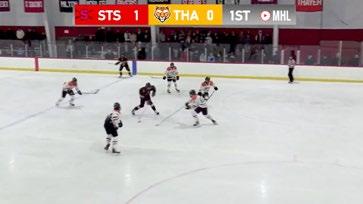
Last school year was a first for bBIG Live and we produced 341 live games providing NEPSAC families, fans, alumni and coaches with professional live broadcast coverage and postgame film. For those that are not familiar with our services here are just a few of the benefits:
• bBIG Live offers professional broadcasting services for a variety of events for parents, grandparents, students, alumni and fans to catch all the action, live or on-demand.

• bBIG Live provides downloadable post-game film for coaches to upload to Hudl or other preferred coaching software.
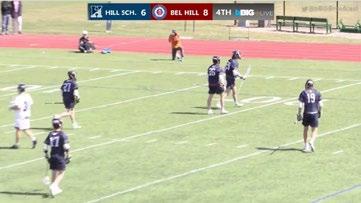



• As a bonus, bBIG Live can also make special announcements, including general school announcements, reminders or shout outs to specific family members or alums watching to personalize the experience.
Contact Mark Igo: 617-823-2492 | info@bbiglive.com


Want to talk scoreboards? You need someone knowledgeable – one who has a complete line of the best scoreboards – someone local – dependable – backed by a company you can rely on. In short, you need Hampden.

When a point is made, all eyes turn toward the scoreboard. It has to work right! That’s why you need Hampden Engineering Corporation as your service dealer.

When Tara McCreery Wood ’84 accepted a job with the NFL in 2006, it was as a temporary, part-time leave replacement. Little did she know that she would spend 17 years working her way up the ranks to become an executive at one of the top professional sports leagues in the world.

“I grew up with three brothers,” Wood says. “My father likes to say, ‘I always knew one of my kids would work at the NFL, I just never knew it would be my daughter!”’
Throughout her career in law and human resources, Wood has often been the only woman in meetings something she “never thinks twice about.” In addition to growing up with brothers, she credits the “undeniable value” of her Dobbs education for her confidence: “I learned not just that I had a voice in the world, but how to use it wisely.”
Wood admits that when she first came to The Masters School as a junior in 1982, “I walked into a classroom with a conference table and chairs, instead of desks in rows, and I panicked! My nature was to hide in the back of the classroom, placing as much distance as possible between me and my teacher.” Although the seminar style of learning took some getting used to, “It has served me well in the long run,” she says.
When offered a temporary, parttime job at the NFL in 2006, Wood jumped at the opportunity. “I was absolutely thrilled to play even a sup porting role in such a prestigious orga nization,” she says. “I never imagined I would remain and grow my career at the NFL for the next 17 seasons.”
As the league’s head of employee relations for nearly a decade, Wood was responsible for “creating and implementing employment policies and practices to cultivate a positive, productive and diverse workplace.” She describes close consultation and collaboration with a number of departments, including HR, legal, compliance, audit and security to “help ensure the successful resolution of employee relations matters and workplace investigations.” She also oversaw annual league-wide workplace conduct trainings.
After graduating from Masters, Wood attended Vanderbilt, where she earned a B.A. in communications; she got her J.D. from Delaware Law School. She practiced law at Epstein, Becker & Greene, P.C. for three years before taking on a role at King World Productions, where she launched its human resources department. “Building a department from the ground up was a very challenging experience,” Wood says. “The strategic and managerial skills I was forced to develop in real time pushed me out of my comfort zone and remain with me today.”
Wood describes moving from a law firm to a fast-paced, live television studio as “a fantastic pivot.” And HR was a good fit for her personality. “I prefer to work directly with employees to reach amicable solutions to workplace issues, as opposed to adjudicating disputes, sometimes years later, in a courtroom,” she explains. While at King World, she met and married her husband, Simon, and they welcomed three children to their family. “Over the years we have always worked together to prioritize and integrate our expanding careers and our amazing family,” Wood shares.
She notes that, while many are familiar with the NFL’s social responsibility initiatives and their global impact, NFL leadership’s care for league office employees “although not publicized, is equally compelling. I was privileged to assist in the quiet channeling of resources, assistance and support given to a number of employees who were facing difficult personal situations. My file folder of handwritten thank you notes is a wonderful keepsake.”
When reflecting on lessons she learned at Dobbs that she carried throughout her career, Wood is quick to mention that it was at Dobbs where she learned to “see my teachers as a valuable resource outside of the classroom.” Because day students couldn’t leave campus before 5:00 p.m. and teachers were often on campus until dinnertime, ‘’When I had homework questions, I would simply pop in and speak one-on-one with my teachers,” she shares. “Those few extra minutes of individual help made all the difference in my effort to master a topic. Subsequently, in college and law school, I would wait after class or visit my teacher’s office for extra help. Even today, I never hesitate to circle back with my boss or colleagues to work through complex business issues - a lasting imprint from my Dobbs teachers.”
As Wood looks back on her career path, her advice to those just starting out is simple: “Make the most of every opportunity you are given, no matter how trivial it may seem at the time. Be open to all possibilities and don’t be afraid to ask for what you need.”
FERRY,

Alumni Weekend 2022 marked the 50th anniversary of coeducation at Taft. It was only fitting, then, that the celebration should include an event 50 years in the making: the creation of The Wandelt-McCarthy Girls’ Lacrosse Fund, endowed by Melissa McCarthy Meager ’74 and honoring the late Ferdie Wandelt. The Fund was introduced during a fieldside ceremony attended by McCarthy Meager, current lacrosse players, students, faculty, alumni, and the Wandelt family.
“This is a really special day and a really special moment for us,” noted Head of School Willy MacMullen ’78, “Melissa is the reason you all are here. When she started at Taft, we had just admitted girls. Of course we had no sports for girls; we were starting from scratch. Melissa had the passion and the courage and the strength to say, we need to have [a girls’ lacrosse program]. She went to Ferdie Wandelt—the legendary director of admissions—and asked him if he would be willing to be the girls’ lacrosse coach. And that’s how it started. 50 years ago, Melissa said ‘we need this, we deserve this, we want this, and this will make Taft a better school.’”
The Fund will be administered by Head Coach Jenna McNicholas and Director of Athletics and Afternoon Program Andy Dunn, who will work together to prioritize the team’s needs, and to identify opportunities that will, Dunn notes, allow a new generation of young women to “pursue excellence through the sport of lacrosse.” McCarthy Meager spent time talking with McNicholas during the process of creating the fund.
“I really wanted to know what Jenna was thinking. What are your priorities? How do you view the team? How do you view excellence? How do you view achieving that excellence?”, McCarthy Meager said. “It was all very much in alignment with how I view coaching and growing a lacrosse team.”
MacMullen took time during the event to reflect on 50 years of girls’ athletics at Taft, recalling some of the school’s legendary coaches, whose photos flanked the podium during the celebration.
“You’ll see some of the figures here who in the history of Taft are these legendary names—these incredible teachers and coaches. Dick Cobb who was of course the girls’ basketball coach who coached 25 seasons, won 200 games, and maybe best of all beat Hotchkiss 25 years in a row. Patsy Odden was the girls’ hockey coach. She became the best girls’ hockey coach in the country and revolutionized girls’ hockey, and graduated girls who went on to play in college and the Olympics and was an amazing advocate for sports. Rusty Davis was the girls’ soccer coach; his string of victories was just outrageous and the girls’ soccer award is named after him. There are men and women who really changed the course and history of the school because of their devotion to girls’ athletics. This is a day to recognize that we stand on the shoulders of giants.”
McCarthy Meager, MacMullen noted, is one of those giants.
“Melissa made an extraordinarily generous gift to endow a fund for girls’ lacrosse. That fund will allow us to do things that we’ve never been able to do, and that wouldn’t happen without her.”
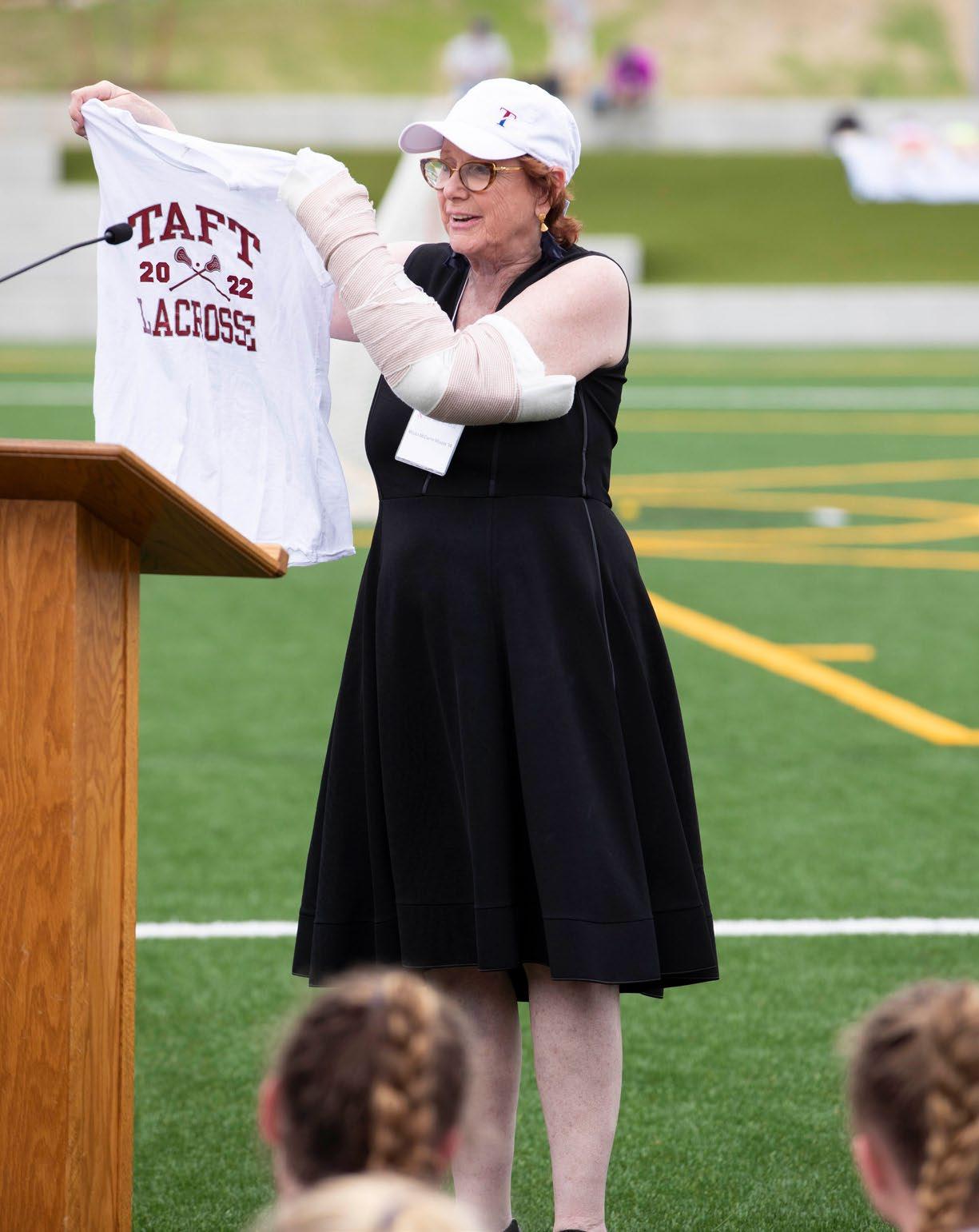
 by Arthur Eddy, ASLA, LEED AP
by Arthur Eddy, ASLA, LEED AP
Sports turf managers know that this time of year can be challenging. The fall sports season is in full swing, and the changing weather takes a toll on athletic fields. This is true on natural grass and synthetic turf fields. Athletes and coaches are creatures of habit. Their skills are built on consistency, repetition and sometimes superstition. Sports turf professionals are observant and pay attention to what is happening in every aspect of a field. Continuous use in certain areas will take a toll on any athletic field and synthetic turf is no exception.
What happens to most high use areas? Regardless of grass or synthetic turf, the area seems to breakdown the fastest due to the overuse. Synthetic turf fiber has memory. If the infill has a ½” reveal, the turf will potentially wear and breakdown at the ½” level. If the turf has a 1” reveal the turf will potentially wear and breakdown at the 1” level. In high use areas, infill is consistently moving, and typically lowering, causing the fiber to be exposed to earlier wear and breakdown than the rest of the field. When not consistently maintained, infill can change from 10mm-15mm over the course of a year. It is very important to keep an eye on infill levels throughout the athletic season.

After testing and walking on hundreds of fields in my career, I’ve found that every field has a “lazy end”. This is the end closest to the gate or locker rooms. For whatever reason, coaches and athletes won’t walk to the far end of the field. They all practice on one side of the field. Practicing on one side of the field leads to high-use and more wear. Typically, the lazy end overtime can have a 5mm-10mm difference in infill. That difference can put a lot of stress on the synthetic turf fiber causing it to breakdown earlier than the other side of the field. On top of the lazy end, most synthetic turf fields are multi-use so, those high use areas typically end up on top of each other. How to fix the wear at the lazy end? Simple rotations on the field can be an easy way to help a synthetic stay safer and last longer. Asking coaches to move practice to the other end of the field on a daily or weekly basis is ideal.
High use areas typically change by sport. Keep in mind that there are several high-use areas around the field that require varying levels of attention but, in this article, we are going to pay attention to some of the more impactful areas.

Lacrosse Goal Mouths: The lacrosse goal mouth areas for men and women are both extremely high use areas and if not paid attention to properly can be detrimental to the turf. This area has the most movement of infill so much so that it can get down to the backing. The constant chopping of the feet of the goalie continuously moves infill.
Soccer Penalty Kick: The soccer penalty kick is another area that gets continuous use and needs regular infill. The continuous kicking motion and practice over and over again can remove all the infill from that area.
Worn out soccer penalty kick.
Field Hockey Penalty Corner Attacker’s Mark: This is one of the areas that most people miss. The right-side penalty corner attackers mark can have little to no infill if not properly cared for.
Center Dot: The center dot of the field is another area that is highly impacted on the field. A wide range of sports are played there but, the lacrosse face-off can really move infill in that area.
Infill levels are critical to the performance, safety and longevity of synthetic turf. Here are some infill tips:
The dreaded Frankenturf.1. High use areas should be checked a minimum of every other week during their respective seasons. Investing an infill depth gauge is the best tool to have to measure infill.


2. Infill depths from across the field should be recorded and logged to follow impacts on the field and provide a guideline for proper replenishment.
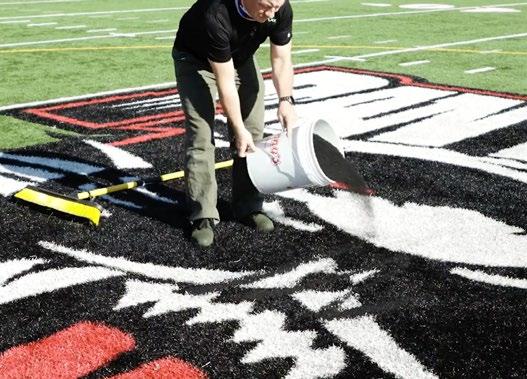
3. Infill should be regularly added to these areas by first brushing with a stiff fiber broom or a steel tined rake to get the fiber to stand up and allow the infill to settle into the turf. Then simply broadcast spread a 5-gallon bucket of infill over the areas and use the broom or rake to work the infill into the high use areas. Continue this process and check infills with the depth gauge as you go.
By now you all know that these synthetic turf fields are not “no maintenance” and just because the field is green, doesn’t mean it is performing. Don’t ignore proper care and maintenance of your field. I cannot tell you how many times we get asked to review a high use area when it is already too late. This begins the cycle of what we like to call “Frankenturf.” Patching and replacement are always a challenge as the turf will never be the same exact pile height or UV wear. Take the extra time to and pay attention to the field to avoid “Frankenturf.”

Arthur Eddy is CEO of RePlay Maintenance in East Greenwich, Rhode Island.

with Art at

or (877) 641-1819.
Adding
NESTMA members advance professionalism in sports turf management and athletic field safety through education, research, and advocacy.
Athletic directors first emerged onto the scene as directors of physical education programs at various institutions. As sports evolved during the 1970s with the passage of Title IX, this position began to encompass various sports programs as well. Accordingly, the job title continues to evolve to include much more than logistics, such as scheduling and hiring. Today’s athletic directors must be effective communicators, in tune with risk management, connected with outside resources, equipped to pivot, and extremely organized forward thinkers.
Vicki Vaughan, Director of Athletics at The Colorado Springs School and a longtime contributor to TrueSport curriculum, shares her experiences as an athletic director, coach, and passionate fan of youth athletics while explaining why your role matters.
Whether you hire outside coaches with a sportspecific budget or you rally teachers to take on coaching roles, as athletic director, you create a culture with the people you hire and by how you set expectations, Vaughan explains. If you think kids should be playing multiple sports throughout the year rather than specializing, you should hire coaches who share that philosophy and who will accommodate students who need to juggle practice schedules, multiple sports, academic classwork, and extracurriculars.
If your school is known for making sports accessible to all students, not just elite athletes, you should hire coaches who are invested in nurturing athletes at all levels. “If I have a coach who puts winning above everything else, then that’s not a good fit for our school,” says Vaughan. “I really focus on finding coaches who align with our school’s philosophies. Yes, it can be difficult, but finding the right coach is worth it in the long run and improves longevity with the partnership.”
When a coach fails to meet expectations, an athletic director must work with the coach on potential improvements. Sometimes, Vaughan says, that means letting a coach go, which can be difficult. But if the coach is no longer serving the students’ needs, it is the athletic director’s job to find a replacement. “Hiring coaches who are a proper fit for our school’s setting is a priority, and when I find them, keeping them is important. I’m especially partial to hiring coaches who are enthusiastic, passionate about their sport, hardworking, proactive and solution savvy, communicative, and connected to young people.” She supports the concept that the athletic director must serve as the coach of all coaches.
Our TrueSport Experts encourage coaches to create team mission statements and rules to live by, but as an athletic director, you can help
shape a school-wide set of expectations and values for athletes and coaches alike. “It’s important to train coaches to send the right messages to athletes, those that reinforce your school’s philosophy and mission,” says Vaughan. For her, that includes selecting coaches who will prioritize helping athletes to meet their potential and learn through the process, not necessarily the outcome. “We work together to find that healthy, fine line between winning and learning,” concludes Vaughan.
Risk management is also a vital component in the job of athletic directors. Today’s coaches are required to be certified in CPR and concussion training while expectations around bullying prevention, heat illness, and safe environments for all athletes is increasing. “In addition to training coaches around safety issues, keeping facilities and fields safe, and designing emergency plans around all scenarios, today’s athletic directors must be prepared to accommodate all new segments of students,” Vaughan states.
Do you arrive early to help set up for the swim meet or stay late to talk to parents after the big
game? Vaughan is clear around the importance of setting an example, adding that as the athletic director, she never asks coaches to do more than she would do herself, which is part of the reason she still coaches girls’ basketball at her school. Another reason is that she enjoys the connectedness with the players and believes that through coaching, she continues to impact young people while helping them to reach their potential.
Vaughan leads by example rather than just setting rules and regulations for others, and she models the behavior she expects from her coaching staff. “Throughout my tenure as AD, I’ve learned to work smarter and proactively, not necessarily harder, and this makes all the difference.” Vaughan adds that effective athletic directors are aware that actions speak louder than words, and recommends remembering that you are always being observed by your athletes, parents, coaches, and peers, whether you know it or not.
Connecting is important within the personal relationships needed for the job as an athletic
TrueSport®, a movement powered by the experience and values of the U.S. Anti-Doping Agency, champions the positive values and life lessons learned through youth sport. TrueSport inspires athletes, coaches, parents, and administrators to change the culture of youth sport through active engagement and thoughtful curriculum based on cornerstone lessons of sportsmanship, characterbuilding, and clean and healthy performance, while also creating leaders across communities through sport.
For more expert-driven articles and materials, visit TrueSport’s comprehensive library of resources
This content was reproduced in partnership with TrueSport. Any content copied or reproduced without TrueSport and the U.S. Anti-Doping Agency’s express written permission would be in violation of our copyright, and subject to legal recourse. To learn more or request permission to reproduce content, click here.

director. “Building relationships is an integral part of my job and maintaining these relationships through proper communication channels is vital,” says Vaughan. “In a typical day, I connect with athletes, coaches, peers, and parents around the clock, whether in person, on the phone, via email, or even with social media.” An effective athletic director thrives in a setting with other people and enjoys making connections with an invested interest in others.
Athletic directors can also help connect coaches to experts who may be needed when dealing with crises among athletes. If an athlete is struggling with disordered eating, anxiety, depression, or any other mental health issues, a coach may not be equipped to deal with it. But as an athletic director, you can make sure that coaches have the resources they need to help athletes in crisis. Vaughan has her “rolodex of experts” on hand and ensures that all coaches in the school know that if a player is struggling, the coach can connect with an expert who can help.
Vaughan plans to begin the fall semester by bringing in a sports psychology and motivational expert to talk to all the athletes in her school. She hopes to encourage students to get involved and play more school sports (something that many schools have been struggling with in the wake of the pandemic). Another reason is to set the precedent that bringing in experts to speak with athletes is a great practice that coaches can implement throughout the season.
“Whenever messaging to athletes can be reinforced with outside speakers and professionals, it places an emphasis on the content and makes a larger impact,” adds Vaughan. “Utilizing other voices to help drive home a message or establish a cultural norm within the athletic department is much more effective than when I speak on my own.”
“Being an athletic director is often a thankless job. It sounds a bit counterintuitive, but a lack of recognition is commendable in most cases,” says Vaughan. When people remain unaware of your duties (e.g., scheduling practices and game times, coordinating transportation, ordering equipment and uniforms, planning with other schools in the district, handling game-day setup and tear down, etc.), that is usually a sign that things are operating steadily. But when events don’t run smoothly, communication isn’t clear, or there are scheduling glitches, this typically
means there are issues to iron out and better work to be done.
“So much of the work is done before the actual event takes place, and planning ahead— envisioning various scenarios and anticipating outcomes— is a good practice,” add Vaughan. An example is when athletic directors are planning for outdoor games and weather becomes an issue. Will the scenario require a date or time change? Is there a weather plan in place to protect attendees? Have the officials been contacted? Who do I need to speak to at the opposing school? “I’ve learned through trial and error that too much planning is better than just enough,” says Vaughan.
As athletic director, your role encompasses so much more than simply scheduling and hiring. It’s easy to get caught up in the day-to-day work that goes with the athletic director position, but in the larger picture, you are capable of creating and reaffirming a culture of sport in your school that will help athletes succeed on and off the court. Help your coaches by clearly defining the principles and values that you want your school’s athletes to maintain, be a positive example, and make sure that you are helping to create a safe environment while nurturing connections where needed.
Please join TrueSport and the U.S. Anti-Doping Agency as we explore mental wellness and the student-athlete. Together, with athletes and experts, we will address the unique mental health stressors facing student-athletes and chart an evidence-informed path forward with actionable takeaways for youth sport influencers.
In recognition of the contributions you make to youth sport, we welcome you to join us virtually for this important discussion on Wednesday, November 16.
An invitation to explore student-athletes and mental wellness…





